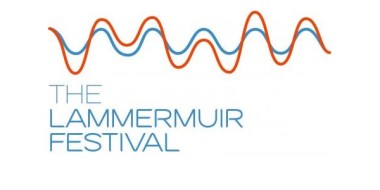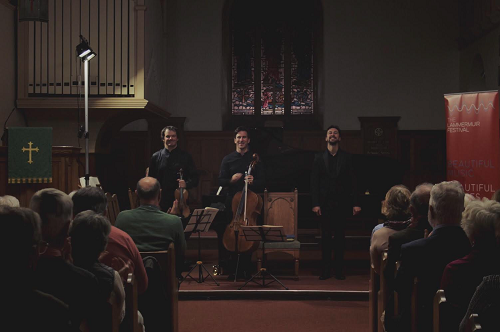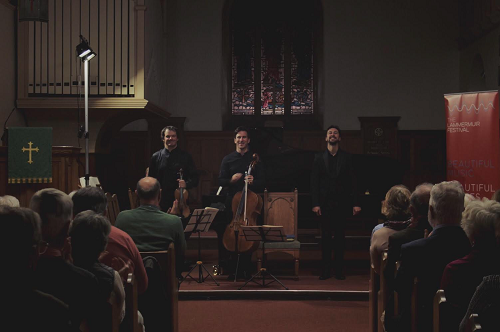
 United Kingdom Lammermuir Festival 2018 (SRT)
United Kingdom Lammermuir Festival 2018 (SRT)

15th September – Gladsmuir Parish Church
Bach: A Musical Offering, Dunedin Consort, John Butt (presenter & director)
15th-16th September – Dirleton Kirk, Dirleton
Schubert: Complete Piano Trios, Magnus Johnston (violin), Guy Johnston (cello), Tom Poster (piano)
Summer is turning decisively into Autumn in Scotland. As I write this, rain is lashing against my window, a chilly wind is blowing and I’m starting to question whether the summer heatwave every really happened. However, as the leaves turn golden and the nights draw in, one of the lovelier things I’ve begun to associate with this time of year is the Lammermuir Festival. This hidden jewel in East Lothian, about 45 minutes from Princes Street, has produced some real musical treats for me over the last few years, and there were lots more on this, its first weekend.
The prosperous hamlet of Dirleton contains a ruined castle and a seventeenth century kirk that, last year, housed a cracking Schubert Octet. It’s the home for more Schubert this year, with two programmes featuring the piano trios and more. Brothers Magnus and Guy Johnston provided the strings, while Tom Poster played the piano, and their blend was a textbook example of what should happen when musicians come together. Their account of the first trio was a thing of wonder, with a fabulous feeling of ‘in full sail’ to the opening, followed by an assertive lyricism to the second subject. The second movement was like a slow Ländler with a restless heart, and the genial scherzo prepared the way for a finale that was shot through with surprising colour and an ending that refused all attempts to usher it quietly over the horizon.
A forcefield of positive energy, Tom Poster is a born collaborator as he shoots his colleagues an encouraging glance from the keyboard, or takes charge of a particular phrase. He, in particular, was a joy to watch as well as listen to in this music. Guy Johnston was less comfortable in the spotlight giving a rather introverted performance in the Arpeggione Sonata with a few pitching niggles, something that made the singing melody of the central Adagio sound rather pale. In contrast, his brother showed energy aplenty in the Grand Duo, sparks blazing from his fiddle during the scherzo before yielding to a gorgeously lyrical slow movement and playful finale.
It takes something of the magic of a festival to be able to hear Schubert’s complete works for piano trio in the space of 24 hours, giving us not just the completed trios but also the Notturno, full of cosy gemütlichkeit, and early Sonatensatz, which seemed to play up the instruments’ conversational capabilities rather than their unity. The highlight, however, came as it should do in the magisterial E flat trio, with its symphonic sense of scale seeming to burst the boundaries of the piano trio form in its outer movements. This performance drew a connecting line between the sighing theme of the second movement and its reappearance in the finale, pointing up the work’s remarkable sense of scale, but it also had a lot of fun in the scherzo, whose Trio had all the schwung of a pub song. It’s quite something that this quiet little kirk has housed three such stellar Schubert evenings in the space of a year: has it inadvertently become Scotland’s finest Schubert venue?
One of the Lammermuir Festival’s loveliest things is the way it produces music in unusual venues like Dirleton. This year’s new discovery for me was the neo-Georgian symmetry of Gladsmuir Parish Church, set in rolling fields just off the A1, but a universe away in terms of its silence and solitude. It housed a real treat in the Dunedin Consort’s tour through Bach’s Musical Offering, and I say tour because our erudite guide was none other than John Butt himself. Butt’s introduction to the Goldberg Variations in Humbie Kirk last year was a model of how to distil the essence of a complex work for a general audience, and his journey through the Musical Offering did the same thing on a grander scale, giving us a summary not just to the work’s historical background and context, but also of how Bach’s movements worked technically (and musically), as well as how they fitted into the wider context and culture of Enlightenment Europe.
Butt is a first rate communicator, combining the learning of a professor (which he is) with the charisma of a natural presenter. I overheard one audience member saying to another, ‘How did he manage to make the most desiccated piece in the repertoire sound like fun?’! His explanations of the canons were all different, be it the Crab canon, so named by Bach, or the Kitten canons, so called by Butt because the lines follow each other around. He even illustrated the perpetual nature of the Canon perpetuus by allowing the audience to choose when it ended by raising their hands, and he depicted the work as a masterpiece of structural management, moving through the academic exercises of the canons through to the masterful climax of the final Ricercar a 6. The musicians sounded predictably delightful, be it in the bouncy strings, the pungent oboe or the limpid flute, but it’s Butt’s explanation that will stick with me the most.
So, too, will the atmosphere, something the Lammermuir Festival rather seem to have made their own. The sun began to stream through the stained glass as the Musical Offering neared its conclusion, and we walked out of the church to be greeted with a view of the patchwork fields and rolling hills of East Lothian, a sight that rather takes the breath away compared to what you normally see when you leave a concert venue. Summer may be turning to autumn, but when it happens amidst a festival like this one, it almost becomes something I look forward to.
Simon Thompson
The Lammermuir Festival runs until Sunday September 23rd. For full details, click here.
